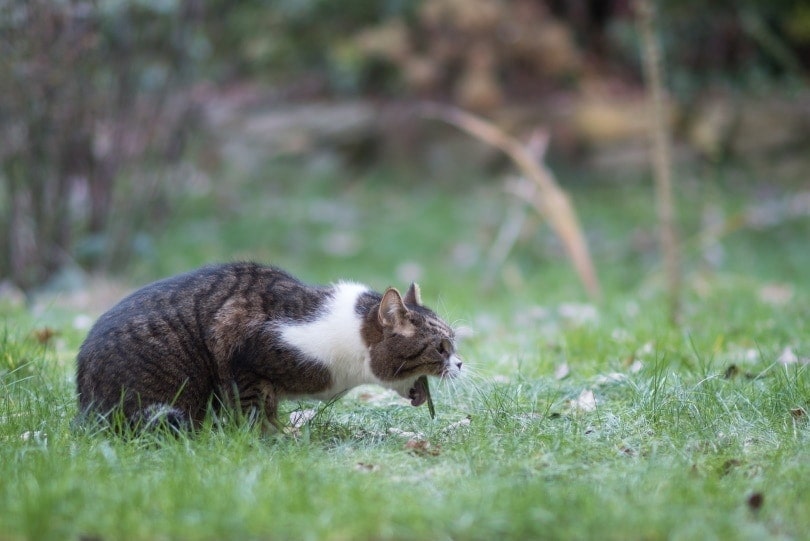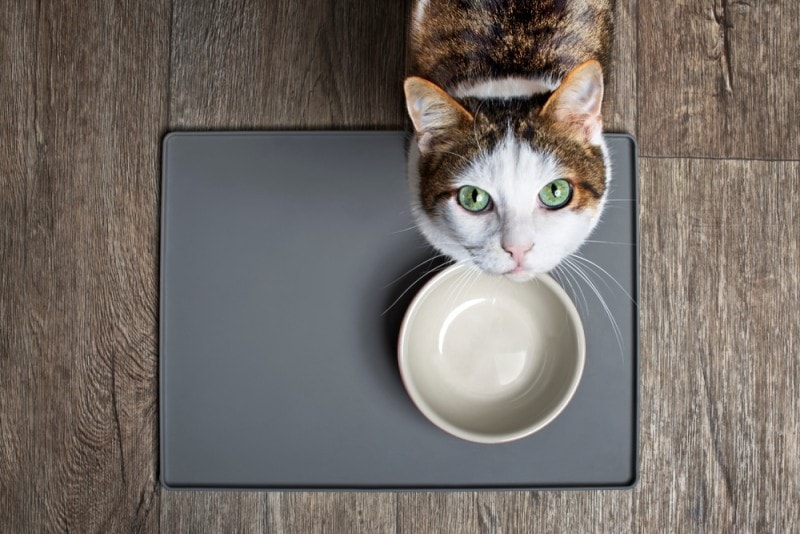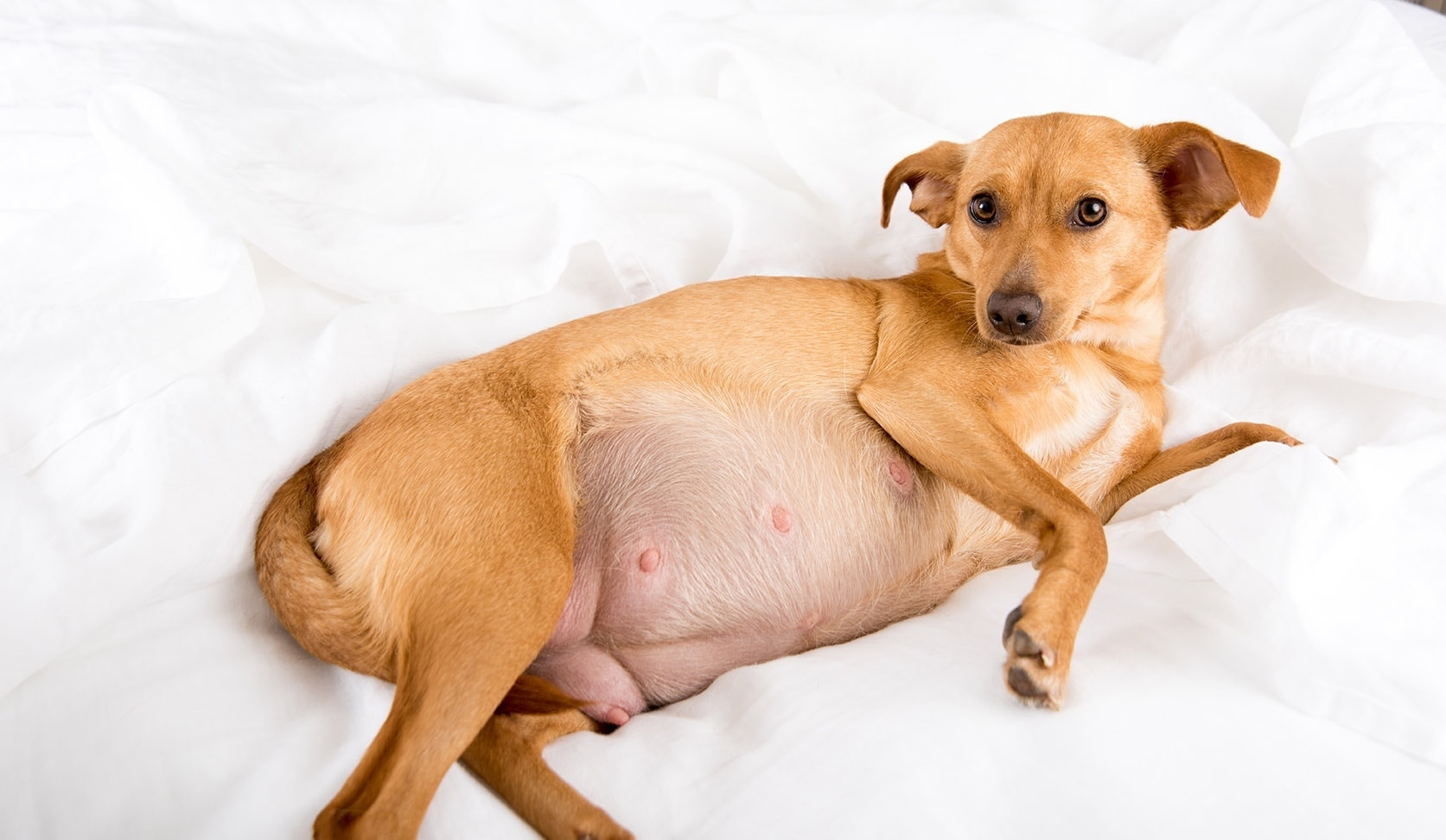Can Cats Eat Bagels? Vet-Approved Facts & FAQ
Updated on

Click to Skip Ahead
Some cats seem to enjoy eating human food, and giving our pets a treat from time to time can make us feel good too. So, if your cat has been showing great interest in your morning bagel, you’re probably wondering if you can safely give a piece to your cat.
While plain bagels aren’t toxic, they aren’t good for your cat and aren’t recommended. Many other bagels contain ingredients that are toxic to cats.
In this article, we fill you in on the details about giving bagels to your cat and healthier snacks that you can offer instead.
Why Can’t Cats Eat Bagels?
The Feline Diet
Cats are obligate carnivores, which means they need nutrients found in animal tissue to meet their requirements. To stay healthy, cats require a nutritionally balanced diet formulated for felines which contains high amounts of protein, moderate amounts of fat and a smaller amount of carbohydrates. They are adapted to preferentially use animal protein as an energy source but can digest carbohydrates.
Bagels are primarily carbs, so although plain bagels are not toxic to cats, they are filling, high in calories and contain no nutritional benefits for your feline friend. While a bite or two of plain bagel is unlikely to cause a problem for most cats, it’s best to avoid giving them some of this snack and find a healthier treat option instead.

What’s in a Bagel?
The average plain bagel contains the following:
- High-gluten bread flour
- Water
- Yeast
- Salt
- Refined sugar
- Shortening/vegetable oil
- Mold inhibitor
Traditionally made bagels are mixed, shaped, refrigerated, boiled, and then baked.
Ingredients
The listed ingredients are for traditional plain bagels. There are multiple different kinds of bagels, but the ingredients that you should worry about when it comes to cats are raisins, garlic, and onions. These are commonly found on everything bagels, for example, and they are highly toxic to cats!

If a cat eats garlic or onion they can suffer from digestive upsets, but there can also be damage to their red blood cells resulting in anemia. Signs that can be seen with garlic or onion toxicity include:
- Vomiting
- Diarrhea
- Pale gums
- Lethargy
- Increased respiratory rate
- Increased heart rate
- Exercise intolerance
- Weakness
Signs will often start to appear within 24 hours of eating the garlic or onion. But signs of anemia can take longer to show up.
Other Ingredients
While ingredients like garlic and onions (including onion and garlic powders and anything else in the Allium family, like shallots and leeks) are specifically toxic to cats, the other ingredients in bagels won’t do your cat any favors either.
As we mentioned bagels are high in carbohydrates and calories. If a cat regularly consumes excess calories in their diet they will gain weight. This will eventually lead to obesity and an increased risk of associated health concerns such as diabetes, heart disease and arthritis.
Salt is another ingredient that can cause harm if a cat has too much of it in their diet. That said, they would need to eat many bagels to suffer from salt poisoning.
Beyond health conditions that might get triggered by eating bagels, cats may experience gastrointestinal issues after eating foods they are not used to.
- Vomiting
- Diarrhea
- Lack of appetite
- Abdominal pain
Toppings
Many people like to add toppings to their bagels, including butter, cream cheese, jam, and peanut butter. But these are full of sugar and/or fats and are not great for cats.
Also, many cream cheese and cheese products contain garlic and onions, so definitely keep those away from your cat, along with anything containing chocolate or caffeine!

Appropriate Snacks for Cats
The best treats for cats are treats made just for them. You can get crunchy dental treats or even lickable treats!
That said, certain human foods are safe and healthy to give to your cat. The important thing to remember is to always give your cat meats and vegetables that are cooked and unseasoned, and everything should be cut up into small bite-sized pieces. Speak to your vet before you offer your cat something new to eat, particularly if they have any health conditions or food allergies.
- Chicken
- Turkey
- Fish
- Beef
- Broccoli
- Peas
- Sweet potatoes
- Pumpkin
- Watermelon
- Strawberries
- Blueberries
- Bananas
FAQ
Can Cats Eat Bread?
Bread isn’t all that different from bagels, so the same rules apply. Bread is high in carbohydrates, can contain harmful ingredients, and can be covered in toppings that aren’t healthy. So, bread is not for cats—while it isn’t toxic, it isn’t good for them either.

Can Cats Eat Bread or Bagel Dough?
Under no circumstances should you give bread or bagel dough to your cat! Dough needs a moist and warm environment to rise, and a cat’s stomach is the perfect environment for this. Raw dough will expand and lead to a bloated and distended stomach, which is painful and can become life threatening.
Additionally, the yeast in dough produces carbon dioxide and ethanol alcohol, which gets absorbed into the bloodstream and can lead to seizures and respiratory failure. If your cat eats even a tiny amount of bread dough, take them to your vet immediately!
How Much Bread or Bagel Can You Give Your Cat?
Anything considered a treat for a cat should only constitute 10% of their total diet. Any bagel or bread that you give your cat should be no more than a small cube the size of a fingernail.
But bagels don’t benefit cats in any way, and many cats might not be all that interested in them to begin with, so it’s best to stick with treats made especially for cats.
Conclusion
Bagels aren’t good for cats as treats. While a plain bagel isn’t toxic and won’t necessarily harm your cat if they have a bite, other bagels and their toppings can contain toxic ingredients. The worst culprits are garlic, onions, raisins, chocolate, and anything with caffeine.
You must be careful when giving human food to your cat in case there’s a hidden harmful ingredient. Speak to your vet if you have questions about your cat’s diet and any other concerns that you might have.
- Related Read: Can Cats Eat Garlic Bread? Vet-Reviewed Facts & FAQ
Featured Image Credit: MSPhotographic, Shutterstock













